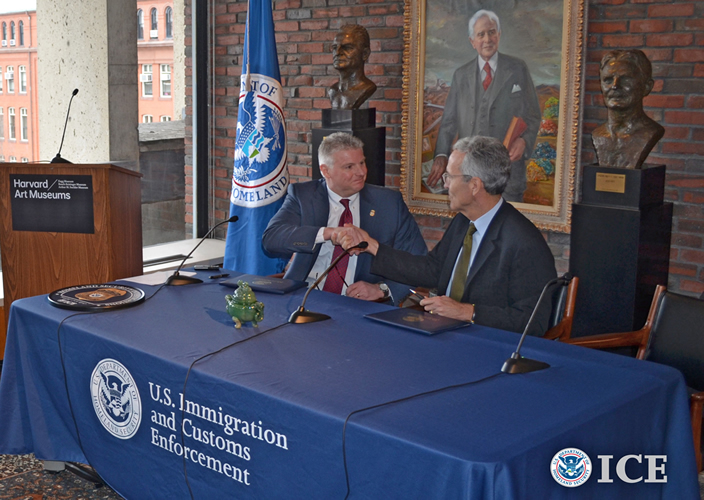ICE returns $1.5 million work of art to Harvard nearly 35 years after theft
BOSTON — U.S. Immigration and Customs Enforcement's (ICE) Homeland Security Investigations (HSI) returned Tuesday an 18th century Qing Dynasty Jade Censer to the Harvard Art Museums, Harvard University more than 30 years after the artifact was stolen.
"We are truly grateful for the engagement and collaboration with U.S. Immigration and Customs Enforcement and the U.S. Attorney's Office over many months while we worked through the necessary channels to return the censer," said Thomas Lentz, director of the Harvard Art Museums, which comprise the Fogg, Busch-Reisinger, and Arthur M. Sackler museums. "Because of their efforts, the censer rejoins our permanent collections just before we open the doors to our newly renovated, state-of-the-art facility this fall, when it will be accessible once again to students, faculty, and scholars."
Returned was a Qing dynasty jadeite incense container, also called a censer. The censer stands approximately six inches high and seven inches wide. The censer dates back to the last imperial dynasty that ruled China.
The widow of Ernest B. Dane, a businessman who graduated from Harvard College in 1892, originally gifted the censer to the Fogg Museum, one of three museums that now constitute the Harvard Art Museums in Cambridge. In 1979, the Fogg Museum opened a small exhibition featuring a selection of jades that the Danes donated, including the censer. On Nov. 26, 1979, Harvard discovered the censer missing from its display. The museum contacted law enforcement authorities and notices regarding the theft of the censer were posted in the Art Theft Archive's newsletter, the Art Dealers Association of America, Inc. newsletter, Interpol's database and the International Foundation for Art Research's stolen item database. Despite these efforts, the censer remained missing for nearly 35 years.
In 2009, Sotheby's auction house in Hong Kong prepared to offer a jade censer for sale in its fall Fine Chinese Ceramics & Works of Art auction. The censer had been hand-delivered to Sotheby's Hong Kong offices by a private seller. Prior to the auction, Sotheby's ran a search in the Art Loss Register, which matched the jade censer being offered for auction with the censer stolen from Harvard. The Art Loss Register then notified HSI of Sotheby's query regarding the censer. HSI special agents notified Sotheby's concerning the origins of the censer and that the censer was listed as stolen in Interpol's Stolen Art Works Database. HSI special agents requested that the auction house withdraw the censer from its auction and Sotheby's complied. The individual who delivered the censer to Sotheby's never provided any documentation regarding the work of art's provenance or ownership.
On July 10, 2012, the United States filed a civil forfeiture complaint against the censer, alleging that the censer constitutes or is derived from proceeds traceable to a stolen good. On Aug. 7, 2013, the court entered a final judgment, finding that the censer is property of the United States. Subsequently, Sept. 25, 2013, the U.S. Department of Justice granted Harvard University's request for return of the censer based on recommendations by HSI and the U.S. Attorney's Office.
The civil case was handled by Assistant U.S. Attorney Veronica M. Lei of U.S. Attorney Carmen M. Ortiz's Asset Forfeiture Unit.
"The censer's long journey home exemplifies the coordinated efforts of law enforcement, our foreign counterparts and Sotheby's, to bring a work of art back to its rightful place at Harvard," said Ortiz. "It is rewarding to see the censer returned to Massachusetts, where students and the public can study and enjoy its beauty and significance for decades to come."
The HSI investigation is still ongoing.
HSI plays a leading role in criminal investigations that involve the illegal importation and distribution of cultural property, including the illicit trafficking of cultural property, especially objects that have been reported lost or stolen. The HSI Office of International Affairs, through its 67 attaché offices in 48 countries, works closely with foreign governments to conduct joint investigations, when possible.
HSI specially trained investigators, assigned to both domestic and international offices, partner with governments, agencies and experts to protect cultural antiquities. They also provide cultural property investigative training to law enforcement partners for crimes involving stolen property and art, and how to best enforce the law to recover these items when they emerge in the marketplace.
Since 2007, more than 7,150 artifacts have been returned to 26 countries, including paintings from France, Germany, Poland and Austria, 15th to 18th century manuscripts from Italy and Peru, as well as cultural artifacts from China, Cambodia and Iraq.
Learn more about HSI cultural property, art and antiquities investigations. Members of the public who have information about suspected stolen cultural property are urged to call the toll-free HSI tip line at 1-866-DHS-2-ICE or complete its online tip form.


